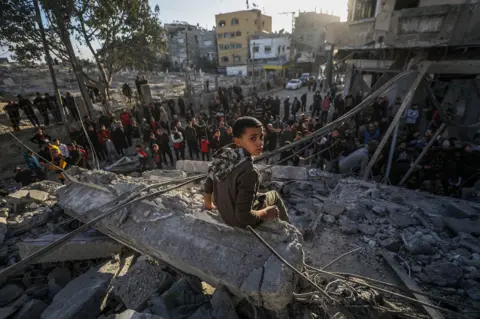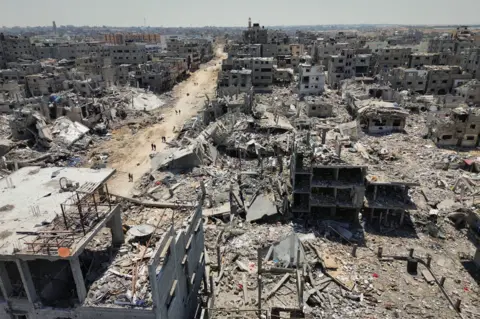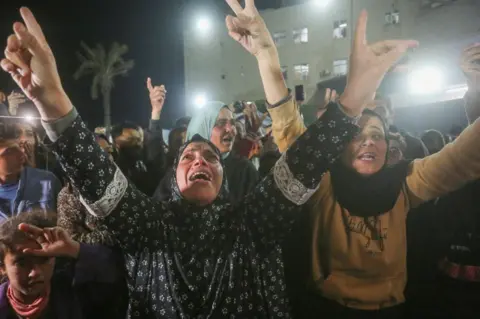 EPA
EPACivilians in Gaza are eagerly awaiting a break in 15 months of incessant war, after the Israeli cabinet approved a temporary ceasefire and hostage release deal with Hamas.
Israel has pounded the Gaza Strip with airstrikes, killing at least 113 people since the tentative deal was reached Wednesday evening, according to the Hamas-run civil defense agency in Gaza.
The agreement, finalized Friday afternoon, is expected to come into force on Sunday, giving Gaza’s population just over 24 hours to take some respite.
“Time passes more slowly than ever,” said Dr. Abdallah Shabir, 27, an emergency doctor at the Baptist Hospital in Gaza City. “At any moment you can lose your life,” he said. “Sitting at home, walking down the street, there is no warning.”
Dr Shabir was on duty at the hospital on Wednesday evening when news of the ceasefire agreement broke. There was a brief moment of joy, he said, but less than an hour separated the announcement from the start of a wave of airstrikes that sent a flood of dead and wounded to Baptiste.
All staff members have been summoned. “It was as bad as we’ve ever seen,” Dr. Shabir said in a phone call from the hospital. “Serious injuries, serious burns. Lots of deaths, of course.”
 EPA
EPAAmong the dead brought in Thursday was a colleague, Hala Abu Ahmed, a 27-year-old internal medicine specialist who two Baptist colleagues described as a dedicated, promising young doctor and a kind person.
She worked tirelessly and under extreme pressure for 15 months since the start of the war, said Dr. Ahmad Eliwah, head of the emergency department, and was killed after the ceasefire was agreed.
Among the millions displaced in the Gaza Strip, many were waiting on Friday to be able to return home for the first time since the start of the war. Many will find a bombed-out wasteland in place of their home.
“My house is completely destroyed, the building is gone,” said Sabreen Doshan, 45, a kiosk owner who lives in a residential building in Gaza City.
Doshan has lost 17 family members since the war began, she said. She was preparing to leave Deir al-Balah, in central Gaza, where she lives in a tent, to reach the ruins of her house.
“Even if I have to set up my tent on rubble, I will be fine because I will be at home,” she said. “No other place can satisfy me now, apart from home.”
The destruction of the Gaza Strip is immense. According to a recent analysis by the United Nations Satellite Center, 69% of all structures and 68% of roads were destroyed or damaged in December. Around 46,700 people were killed, according to the Hamas-run health ministry.
Israel set out to destroy Hamas in Gaza in October 2023, after the group attacked southern Israel, killing around 1,200 people and taking 251 hostages.
For Gazans, the joy of the long-awaited ceasefire was tempered by the scale of death and destruction. “By God, it’s a mixed feeling,” said Wael Muhammad, an independent journalist living in a refugee camp in central Gaza.
“From one moment to the next, from joy to pain,” he said. “I am happy that the torrent of blood has stopped, but we live in misery.”
 Getty Images
Getty ImagesAs of Friday afternoon, the ceasefire agreement was making its way through the Israeli political system for final approval. It paves the way for the release of a first group of three hostages on Sunday, in exchange for some 95 Palestinian prisoners.
But the exchange, which will take place over the next six weeks, carries many risks of collapse.
“The biggest challenge is whether the ceasefire will be implemented successfully,” said Juliette Touma, communications director for the United Nations refugee agency, UNRWA.
“If so, the challenge ahead remains absolutely enormous. The vast majority of shelters are overcrowded. Many simply live in the open or in makeshift structures. They lack basic needs like clothing hot. I would not describe these living conditions as “these are not conditions worthy of human beings. »
On Friday in Gaza, some focused on Sunday and wondered whether they would be able to take advantage of this respite without the deal collapsing.
“We are afraid of any change, of any movement,” said Khalil Nateel, 30, whose home in Jabalia, in the far north of the Gaza Strip, was destroyed at the start of the war.
“The news is good,” Nateel said from a shelter in central Gaza. “We watch and wait.”



